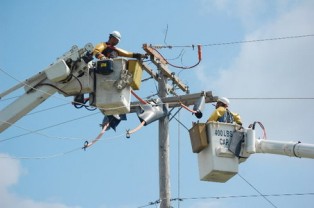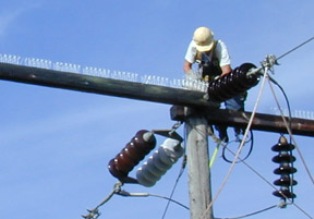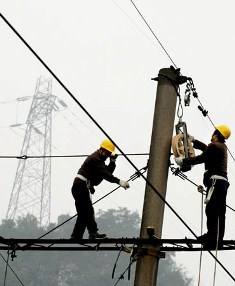Safety when working on overhead line supports
Works on overhead line supports are particularly difficult from the point of view of organizing safe working conditions for the following reasons: the work is associated with climbing supports at a great height, the workplaces change daily, and sometimes several times a day, electricians are dispersed at workplaces along the overhead line, from each other at the flight distance between the supports, which makes it difficult to monitor the safety of their work, the work requires constant monitoring of the condition of the grounding devices, as well as constant checking of the absence of voltage in the disconnected circuits of overhead lines, the work is related to the weather conditions, the condition of the access roads and the structure of the supports.
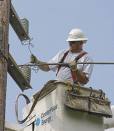 In this regard, attention is required from each member of the brigade, strict compliance with all safety requirements and tireless control over their actions and the environment.
In this regard, attention is required from each member of the brigade, strict compliance with all safety requirements and tireless control over their actions and the environment.
All electric line carriers are required to undergo an annual climbing medical examination and confirm the assigned electrical safety group… Newly hired workers, after a medical examination, must undergo an overhead line work training course and a knowledge test, followed by an appointment to an electrical safety group.
Overhead works, from the point of view of safety measures, are divided into the following five categories:
-
on disconnected overhead lines;
-
on live overhead lines;
-
on disconnected overhead lines, but located near existing power lines above 1 kV;
-
on an open circuit of a double-circuit line when the second circuit is energized;
-
of the disconnected phase of the line when the other two phases are live.
 Specially trained and highly qualified electricians-line specialists accepted by the commission are allowed to work under voltage. It is strictly forbidden for the personnel of electrical installation organizations to carry out work on overhead lines that are under voltage.
Specially trained and highly qualified electricians-line specialists accepted by the commission are allowed to work under voltage. It is strictly forbidden for the personnel of electrical installation organizations to carry out work on overhead lines that are under voltage.
Any work on an operating overhead line is carried out subject to mandatory compliance with the following conditions: to carry out work, an order (written or oral) must be issued to a person authorized for this, work on overhead lines must be carried out by at least two persons , while a person must have an electrical safety group of at least III, before the start of electrical work on overhead lines, organizational and technical measures must be taken to ensure the safety of the work.
Organizational activities include: registration of work by order or order, registration for admission to work or permission to start work, supervision during work, registration of the end of work.
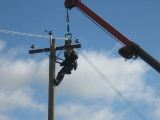 Lineman electricians are allowed to start work on the overhead line only with a permit issued by the organization responsible for that overhead line.
Lineman electricians are allowed to start work on the overhead line only with a permit issued by the organization responsible for that overhead line.
Clothing-reception — this is a written order that determines the composition of the team, the content of the work to be performed, the place, time and conditions of the work, as well as the persons responsible for the safety of the work. If the airline for which it is issued the permit, passes through the territory of the operating enterprise, then the team of electricians-linear machines must additionally receive from this enterprise a certificate of acceptance for the right to work on its territory.
The following persons are responsible for the safety of the work on the overhead line: the responsible head of work, organizing the work by the electrical installation organization, the operational staff of the enterprise responsible for the overhead line, issuing a permit, ordering the suspension of the overhead line and allowing the start of work, the manufacturer works, in the name of which a work permit is issued, directing the work on site by the electrical installation organization.
A responsible leader can be a person from the engineers who has electrical safety group not lower than V. He is responsible for the possibility of safe production of work, the fulfillment of the entire list of works, the adequacy of the qualifications of the persons appointed to perform the work.
From the manufacturer of works, there may be a person from the foremen or foremen (foremen) who have an electrical safety group of at least IV.He is responsible for compliance with safety rules by workers and all provisions in the work permit, the correct placement of people at the workplace, the operability of the protective equipment available in the team, for devices and tools, and provides continuous supervision of workers.
Operational personnel of the enterprise are responsible for the correctness of the issued work permit, the strict implementation of all technical measures specified in the permit, for the quality of instructing persons authorized to work at the workplace, for the admission of the brigade to the prepared work area.
Technical activities include: de-energizing the overhead line via switches and line disconnectors, grounding overhead line at both ends, hang placards on switch switches and line disconnector drives "Do not turn on - work on line", hazardous area fence, hang placards "Work here", "Enter here", "Grounded" in the places indicated in the order - reception, checking the absence of tension during the reception of the brigade in the presence of all members of the brigade, the manufacturer and the responsible head of work.
The absence of voltage is checked by approaching an insulating rod with a voltage indicator attached to it to the wires of the overhead line. Checking the absence of tension in the wires of the overhead line by throwing a steel wire is strictly prohibited!
The grounding of the overhead line phases is carried out by applying and fixing a portable earthing on the overhead line conductors.When laying grounding, the grounding conductor is first connected to the grounding conductor (wooden or reinforced concrete support) or to the grounded parts of the metal support, and only then it is allowed to apply and fix the portable grounding clamps on the wires of the overhead line. Artificial grounded electrodes are arranged by driving a metal rod (scrap) into the ground or screwing in a special drill at a depth of 0.5 — 1 m.
The use of conductors not specially designed for these purposes for grounding and short-circuiting the overhead line conductors is prohibited.
In the absence of visible grounding of the wires of the overhead line at the place of work, it is strictly forbidden to climb on the support, work on wires and insulation threads.
Methods of lifting workers to perform work on overhead lines
The most productive and safer way to lift workers to perform work at height is lifting with the help of special lifting devices, aerial platform, auto-hydraulic lift, etc.
All work on overhead line supports belongs to the steeplejack, therefore, when ensuring the safety of those working on supports, garlands, wires and lightning protection cables, safety rules must be strictly followed.
If there are factors that prohibit or limit the use of mechanized lifting equipment (aerial platforms, auto-hydraulic lifts) or in the absence of these machines and mechanisms, the simplest way to raise the height along the support of the overhead line should be used.
Currently, light portable devices are used that provide the ability to safely lift workers onto supports and perform work both on the supports themselves and on the wires of the supports, on the wires and lightning protection cables. These devices include ladders, swings of various designs, as well as mounting nails, nail nails, etc.
For lifting on a metal support, it is allowed to use the supporting structure, as a result of which factories are produced power line poles with height more than 20 m, special stairs or steps, and on supports with a height of up to 20 m, steps are carried out only if the slope of the angles of the grid is more than 30 ° and when the distance between the points of attachment of the grid to the belts is more than 0, 6 m.
Special cable shafts and overhead ladders must be used to climb a reinforced concrete centrifugal support with a circular cross-section.
For lifting on wooden and reinforced concrete vibrating supports, nails of various designs are used.
Safety rules for lifting and working on an overhead line
Before lifting up to the support with nails, you must first make sure that the support is fixed in the ground or reinforced concrete glass. Lifting a newly installed support without the permission of the contractor is strictly prohibited.
It is permitted to carry out work on reinforced concrete and wooden supports only while standing on two nails and tied to the support with a sling (chain) from a safety belt.
Before climbing a wooden support, it is mandatory to check that the decay of the applied part does not exceed the permissible speed, and if the support is on the steps, you must check the reliability of its connection with the reinforced concrete step.
Before lifting to the support, the manufacturer of the work must check the condition of the ladders, safety belts, nails, belts used and make sure that the period of their periodic testing (according to the brand) has not expired and they are suitable for use in work.
Ladders must be fixed to the support at all attachment points provided by the structure.
When lifting on a support, do not carry fittings, equipment and materials with you. All loads, including tools, bodies and small parts, can only be lifted with a special (hemp, nylon or cotton) rope through a block mounted on a support (travers). Workers standing on the ground and observing the work from above lift the load.
Having climbed the support, the master electrician can begin work only after taking a stable position on the claws and securely attaching the safety belt with a chain (sling) to the support post above the traverse. When working at height from a cradle on a telescopic tower or a hydraulic lift, the seat belt chain must be attached to the guard of the cradle. The seat belt must be fastened with all seat belts.
When moving the aerial platform or hydraulic lift from one support to another, the master electrician should not be in the cradle.
You cannot be the support on which the work is done.The personal tool of a master electrician, when working on a support, wires or garlands, must be in a special bag to prevent it from falling. It is forbidden to store the tool in the pockets of the overalls, even temporarily.
It is forbidden to climb on the anchor support and stand on it during the installation of wires from the side of the tensioned wire, as well as to climb on the corner supports and work on them from the side of the inner corner of the wires.
When dismantling the wires, it is forbidden to remove all the wires from the support at once: they must be dismantled one by one, one after the other.
To prevent the worker from falling with the support when removing the last two wires, the support must be strengthened on three to four sides with temporary clamps or restraints, and at the same time two adjacent supports must also be strengthened.
Dismantling the wires when replacing the supports should start from the lower wire, and the installation of the newly installed support - from the upper one. When re-laying the wires, the worker must stand with both claws on the new support. It is forbidden to stand with one nail on the old support and the other on the new one.
Electricians are allowed to move along the overhead line on wires with a cross-section of at least 240 mm2 and on cables with a cross-section of at least 70 mm2. When moving along separate wires and cables, the sling of the safety belt must be fixed to this wire, and in the case of using a special trolley - to the trolley. In the dark, moving along the wire is strictly prohibited.
It is forbidden to work on the supports of an overhead line parallel to a working overhead line, because during the installation work it is possible for wires or supports of the installed overhead line to come dangerously close to the wires of the operational overhead line.
Climbing the support without a safety belt and working on the traverse without securing it is prohibited.
When climbing a support, it is not allowed to attach the end of a lifting cable or rope to the safety belt; for this purpose, a nylon cord should be used, which should always be in the bag of a master electrician.
To lift the load (the end of a cable or rope, a tool, etc.), it is necessary to attach one end of the nylon cord to the support elements and lower the other end down (preferably through a block attached to a traverse) to tie the the cargo.
Disassembled lifting cables and accessories must not be discarded from the support. Their descent is carried out using a rope and a block, while the workers below must be warned of the need to move to a safe area. It is forbidden to place temporary structures, mobile wagons, warehouses and people in the danger zone.
It is forbidden to climb on the support of the crane boom to remove lifting devices or perform other operations at height.
To raise the worker to the height of the support of the overhead line or catenary, stationary ladders fixed on the supports or special assembly ladders installed on the supports for the period of installation work are used.
Mounting trolleys are used to safely mount spacers on overhead wires.Electrician-managers trained in practical driving of overhead wire trolleys and passed an examination in accordance with the rules for using the trolley are allowed to work with such a trolley.
The landing of the worker in the assembly trolley is allowed only after its final installation on the wires of the overhead line. After entering the cart, the worker is required to insure himself for two wires. When moving the cart along the wires, the electrician must wear gloves. It is forbidden to leave the assembly trolley in the spring.

